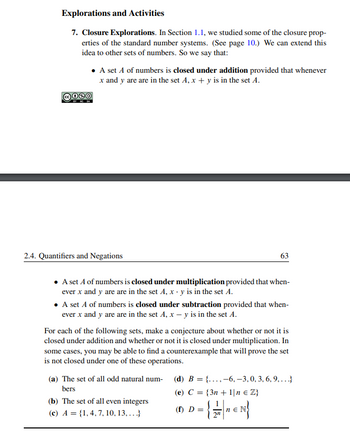
Advanced Engineering Mathematics
10th Edition
ISBN: 9780470458365
Author: Erwin Kreyszig
Publisher: Wiley, John & Sons, Incorporated
expand_more
expand_more
format_list_bulleted
Question
Need help with problems 7a and 7f

Transcribed Image Text:Explorations and Activities
7. Closure Explorations. In Section 1.1, we studied some of the closure prop-
erties of the standard number systems. (See page 10.) We can extend this
idea to other sets of numbers. So we say that:
BY NO SA
• A set A of numbers is closed under addition provided that whenever
x and y are are in the set A, x + y is in the set A.
2.4. Quantifiers and Negations
A set A of numbers is closed under multiplication provided that when-
ever x and y are are in the set A, x - y is in the set A.
63
• A set A of numbers is closed under subtraction provided that when-
ever x and y are are in the set A, x - y is in the set A.
For each of the following sets, make a conjecture about whether or not it is
closed under addition and whether or not it is closed under multiplication. In
some cases, you may be able to find a counterexample that will prove the set
is not closed under one of these operations.
(a) The set of all odd natural num-
bers
(b) The set of all even integers
(c) A = {1, 4, 7, 10, 13,...}
(d) B = {..., -6, -3, 0, 3, 6, 9, ...}
(e) C = {3n+ 1\n € Z}
(f) D = = {2₁€N}
Expert Solution
This question has been solved!
Explore an expertly crafted, step-by-step solution for a thorough understanding of key concepts.
This is a popular solution
Trending nowThis is a popular solution!
Step by stepSolved in 4 steps with 4 images

Knowledge Booster
Similar questions
- For each of the following types, write a problem of that type, draw a strip diagram or number bond (as appropriate) and formulate two equations for that problem, one using addition and one using subtraction. A Put Together/Take Apart, Addend Unknow problem. Two versions of a Compare, Difference Unknown problem; one formatted with “more” and one with “fewer”arrow_forwardMultiplication Problem 6: Find A x B A = = B = 12 34 - 1 0 1 2arrow_forward5.Simplify a. b. C. d. 4x 1 3 4x - 4 3 3x - 3 4 3x-1 4 x-1 3/4arrow_forward
- The following is known about three numbers: Three times the first number plus the second number plus twice the third number is 5. If 3 times the second number is subtracted from the sum of the first number and 3 times the third number, the result is 2. If the third number is subtracted from 2 times the first number and 3 times the second number,the result is 1.(b) Find the numbers using ??????′? ?????arrow_forwardAnswer pleasearrow_forwardProblem. Let R be the region given by 0 < z < x² + y² , x² + y? < 3. Evaluate (x + 2)dV. Explanation. This is the region under a paraboloid and inside a cylinder. The reason cylindrical coordinates would be a good coordinate system to pick is that the condition x² + y? < 3 means we will probably go to polar later anyway, so we can just go there now with cylindrical coordinates. The paraboloid's equation in cylindrical coordinates (i.e. in terms of r, 0, and z) is ? z = x + y? Thus, our bounds for z will be くzく Now that we have z, we can look at the cy-plane for our polar bounds. The disc x² + y² < 3 in polar isarrow_forward
arrow_back_ios
arrow_forward_ios
Recommended textbooks for you
 Advanced Engineering MathematicsAdvanced MathISBN:9780470458365Author:Erwin KreyszigPublisher:Wiley, John & Sons, Incorporated
Advanced Engineering MathematicsAdvanced MathISBN:9780470458365Author:Erwin KreyszigPublisher:Wiley, John & Sons, Incorporated Numerical Methods for EngineersAdvanced MathISBN:9780073397924Author:Steven C. Chapra Dr., Raymond P. CanalePublisher:McGraw-Hill Education
Numerical Methods for EngineersAdvanced MathISBN:9780073397924Author:Steven C. Chapra Dr., Raymond P. CanalePublisher:McGraw-Hill Education Introductory Mathematics for Engineering Applicat...Advanced MathISBN:9781118141809Author:Nathan KlingbeilPublisher:WILEY
Introductory Mathematics for Engineering Applicat...Advanced MathISBN:9781118141809Author:Nathan KlingbeilPublisher:WILEY Mathematics For Machine TechnologyAdvanced MathISBN:9781337798310Author:Peterson, John.Publisher:Cengage Learning,
Mathematics For Machine TechnologyAdvanced MathISBN:9781337798310Author:Peterson, John.Publisher:Cengage Learning,


Advanced Engineering Mathematics
Advanced Math
ISBN:9780470458365
Author:Erwin Kreyszig
Publisher:Wiley, John & Sons, Incorporated

Numerical Methods for Engineers
Advanced Math
ISBN:9780073397924
Author:Steven C. Chapra Dr., Raymond P. Canale
Publisher:McGraw-Hill Education

Introductory Mathematics for Engineering Applicat...
Advanced Math
ISBN:9781118141809
Author:Nathan Klingbeil
Publisher:WILEY

Mathematics For Machine Technology
Advanced Math
ISBN:9781337798310
Author:Peterson, John.
Publisher:Cengage Learning,

